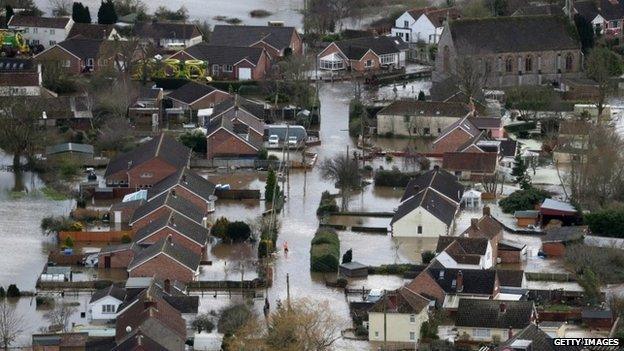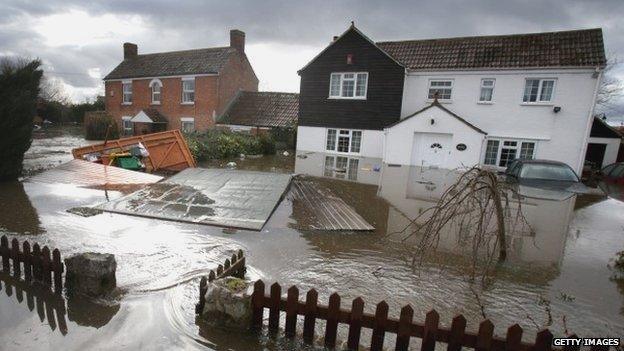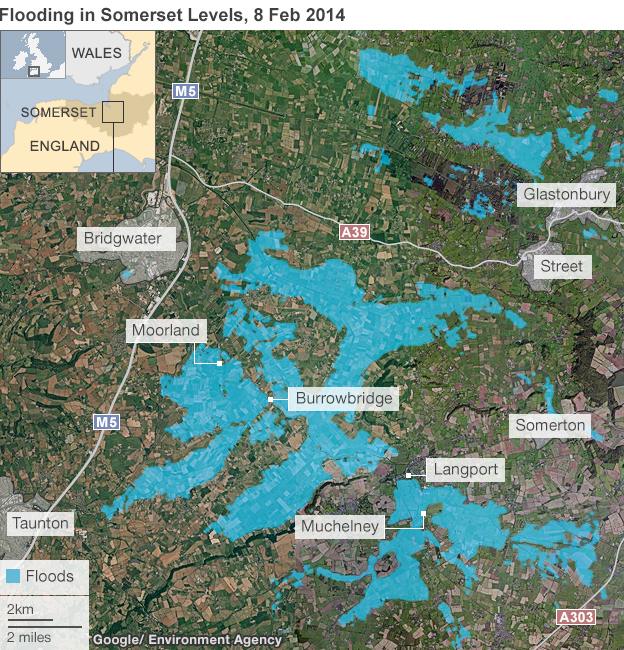Government pledges £10.5m for Somerset flood scheme
- Published

Flood water surrounded properties in the village of Moorland on the Somerset Levels
Funding of £10.5m has been announced towards the cost of a £100m draft flood prevention scheme for Somerset.
The Somerset Levels and Moors Flood Action Plan, external outlines measures including dredging, a tidal barrage and extra permanent pumping sites.
The Department for Transport is backing it with £10m and the Department for Communities and Local Government with £500,000.
That is in addition to £10m already announced by David Cameron.
The prime minister has said "money is no object" in sorting out the flooding problems.
A further £1.5m towards the cost has already been raised from Somerset local authorities, drainage boards, the Environment Agency and the Royal Bath and West Society.
Funding partnership
The action plan - commissioned by Environment Secretary Owen Paterson - was compiled by Somerset County Council, the Environment Agency, residents and other interested parties.
It aims to prevent the sort of flooding which has affected Somerset's Levels and moors over recent months.
Asked where the remaining money to fund the proposals would be found, Mr Paterson said 'money no object' was a reference to the immediate recovery from flooding. "But what I am launching today is the 20-year plan," he said.
Mr Patterson welcomed the £20.5m already put forward as an "extremely good start" and said there would be "significant national money".
But he added: "I also think it is right there should be a partnership with locals raising money locally, doing further work which is not currently being done, and all that together will make a very good package that really will make the levels a much more stable place over the next 20 years."

The plan includes looking at extra permanent pumping sites to help clear water off the Levels more quickly
Somerset County Council Leader John Osman said: "The plan contains some firm ideas for what we can do now, but also some broad ambitions such as a sluice or barrage for the River Parrett and long-term projects to prevent water entering the area in the first place.
"We listened to local people in drawing up the plan and we will spend a lot of time now talking and listening to them again to ensure the plan is fit for purpose and supported by local people.
"I am particularly pleased that the Department for Transport has made such a significant contribution. We are very grateful."
Among the first to see the plan was the Flooding on the Levels Action Group (Flag) chairwoman Heather Venn, who said the group was "cautiously optimistic".
"We need to keep a careful eye on this and it is absolutely crucial that the funding is there, but it is a very positive first step and we welcome much that is in it," she said.

In addition to essential measures, the plan suggests considering a further £203.78m of flood management work
Measures the plan lists as "must" be taken include:
Dredge the first five miles (8km) of the Rivers Tone and Parrett to the 1960s river profile
Increase the capacity of the Sowy King Sedgemoor Drain
Make permanent the temporary pumping sites at Dunball by autumn 2014
Accelerate the construction of a barrier or sluice at Bridgwater, with the objective of achieving delivery by 2024
Repair and resurface 28 miles (44km) of flood-affected roads
Establish a Somerset rivers board that has greater control and responsibility for work to maintain and improve water management on the levels
In addition, the plan suggests looking at other measures which could cost £203.78m on top of the £100m.
These include raising the levels of the A361, the A372 and other roads, as well as the railway between Taunton and Bridgewater, by as much as 2m (6ft 6in).
An initial assessment of whether it is more cost effective to raise transport links than manage the river system will be delivered by the autumn.

Anthony Gibson, chairman of Somerset Water Management Partnership, said: "At the heart of it [the plan] is a determination to reassert control over the water and to do that by tackling the problem from every side.
"If you do all of those things then you will vastly reduce the flooding risk."
Alistair Mullineux, who lives in Muchelney which has been cut off by flood water since just after Christmas, said having permanent pumps would help in the future.
"It will get the water away quicker, the trick is to get that first lot of water away when the heavy rain comes, get rid of that and the rivers are more capable of holding what comes later," he said.
- Published5 March 2014
- Published5 March 2014
- Published5 March 2014
- Published19 March 2014
- Published20 February 2014